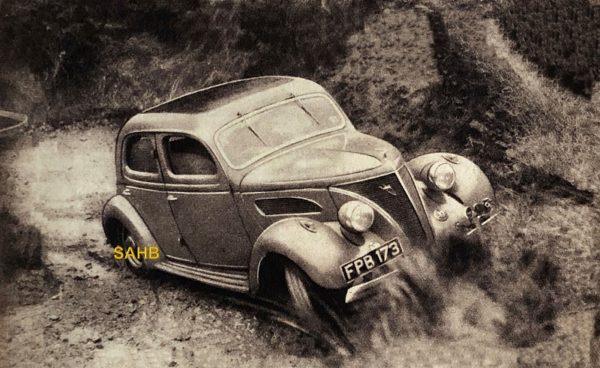
The M.C.C. Sporting Trial of 1937 took in this fiendishly challenging hill in the Derbyshire High Peak known as Jenkins Chapel. By all accounts the weather was appalling, so the fact that this Ford V8, driven by McEvoy, received a Premier award says something for McEvoy’s skill and the toughness of the car.
In our Snapshot is a ‘baby’ Dagenham-built version of the 1937 car known in the USA as the V8-60 and in Britain as the 22 HP. It differs from its larger sister car (the 78, or 30 HP in Britain), not only in its smaller engine but in some distinctive bodywork details: instead of the streamlined faired-in headlamps introduced for 1937 on the bigger car, it has separate units standing proud of the wings. The bonnet-side grilles are curved at the front, matching the shape of the sides of the radiator grille.
The history of this model started with a failure but ended in success; in 1934, Ford of Dearborn designed and produced a smaller version of the company’s standard V8 for its European divisions in Dagenham and Strasbourg. It was a curious engineering design: this first version featured four main bearings and only two exhaust ports per bank, and it was plagued with problems, especially overheating. Only around 3,300 examples were produced and almost none survive.
However, the ideas were sound enough to inspire a second, redesigned V8 for Europe, introduced in the United States in 1937 as the V8-60 – its power output. In Britain it was commonly known as the 22 hp V8, in reference to its taxable power rating, while in the USA the Ford ads named it the “Thrifty Sixty.”
The redesigned V8-60 of 1937 was a miniaturized version of the original flathead Ford V8 introduced in 1932, with its displacement scaled down from 221 cubic inches (3.6 litres) to 136 (2.2 litres). Its output of 60 bhp compared with the 85 bhp of the larger engine. Power may have been good enough, but its greatest shortcoming was lack of torque: 50 percent below that of the bigger engine and even less than produced by the much earlier Model A.
Initial sales were brisk, helped by the car’s fuel economy, but soon declined as customers discovered its lack of performance. The V8-60 was discontinued in the USA after 1940, but the 1946 Dagenham-built V8 Pilot initially sold with this engine, until, once again, lack of performance forced Ford to replace it with a British-made version of the 3.6-litre.
It may therefore seem strange to see the lower-powered car doing so well in the 1937 trial. But cars (and, in the USA, power boats) with this engine were highly successful in competition, in particular in categories with displacement limits. Perhaps McEvoy was racing under such rules.
Photo courtesy of The Richard Roberts Archive.







Leave a Comment